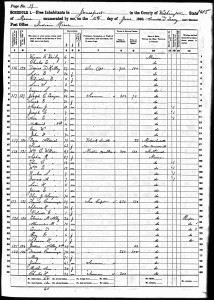 Have you ever played the game telephone? If you don’t know the game, it is when one person whispers a message to another, which is passed through a line of people until the last player announces the message to the entire group. If you have, then I am sure you discovered that it is almost impossible to keep the story intact from beginning to end. The game is an interesting teaching tool, as it shows children (and adults) how easily and unreliably gossip can spread.
Have you ever played the game telephone? If you don’t know the game, it is when one person whispers a message to another, which is passed through a line of people until the last player announces the message to the entire group. If you have, then I am sure you discovered that it is almost impossible to keep the story intact from beginning to end. The game is an interesting teaching tool, as it shows children (and adults) how easily and unreliably gossip can spread.
As a historian and genealogist, I often reminisce about the telephone game, because it was my first encounter with record assessment. Even as a young child, it was clear to me that the closer one was to the original source, the more reliable the information. And, as I grew up and began working with historical documents, this lesson continued.
As a genealogist on the reference desk at NEHGS, and now as Director of Research Services, I always recommend researching with an original record. Never accept transcriptions as an acceptable resource, as the original is always better. Additionally, it is important to know whether you are looking at the original record, or a copy of the original. Yes, some records that look original are actually copies: vital records, deeds, and probate and census records, to name a few.
Of all of the record types, the census hit me the hardest. I never imagined that the United States Federal Census could be a copy of the original enumeration:
From 1790 to 1880, the United States Federal Census was copied, either two or three times, and filed once in its respective county and second on the federal level. As a result, the census records that you see today, either on microfilm at the National Archives or digitally on Ancestry.com, are the census sheets that were forwarded along to the federal government. These federal records may be the original enumerations, or one of the copies made. Generally it is impossible to tell whether the federal copy is an original or a copy, but in some cases it is possible to note the differences.
- The first, and most obvious, is to note the order in which names are listed. If names are in alphabetical order, or grouped by the first letter of surname, then it is safe to say that the enumeration is a copy of the original. I’ve seen this most often with the earlier censuses (1790–1820), as census enumerators were required to hang two copies of the census in “two of the most public places” so the public could check for accuracy.
- Later censuses (1830–1880) were copied by someone other than the original enumerator. Therefore, to assess whether the federal copy was an original or a copy, look at the census returns for the whole county. If the handwriting is the same for each town, then it is probable that you are looking at a copy.
- Find the original, either at the county level or on microfilm. For example, some county copies of the United States Federal Census have been microfilmed by the Family History Library. If you are able to locate the county copies, you can the compare them to the federal records. Generally speaking, the original enumerations will have additional information compared to the federal copy.
See, for example, these two returns from Washington County, Maine (1860):
Note that the county copy (above) included the name of Robert M. Alley, with the notation “omit–prisoner”; the Federal copy (below) drops Robert altogether.
In this case the original record provided more information than the federal copy. Therefore, it is essential, when working with any record, for researchers to seek out an original. Like the game of telephone, the original source will always provide more accurate information than the repeated version.
*
If you would like to know more about the hidden gems of the US Federal Census, please see my webinar.
Share this:
About Lindsay Fulton
Lindsay Fulton joined the Society in 2012, first a member of the Research Services team, and then a Genealogist in the Library. She has been the Director of Research Services since 2016. In addition to helping constituents with their research, Lindsay has also authored a Portable Genealogists on the topics of Applying to Lineage Societies, the United States Federal Census, 1790-1840 and the United States Federal Census, 1850-1940. She is a frequent contributor to the NEHGS blog, Vita-Brevis, and has appeared as a guest on the Extreme Genes radio program. Before, NEHGS, Lindsay worked at the National Archives and Records Administration in Waltham, Massachusetts, where she designed and implemented an original curriculum program exploring the Chinese Exclusion Era for elementary school students. She holds a B.A. from Merrimack College and M.A. from the University of Massachusetts-Boston.View all posts by Lindsay Fulton →

